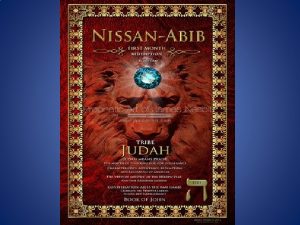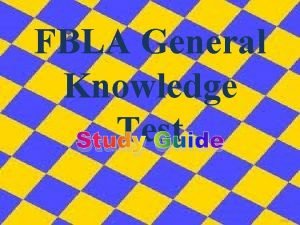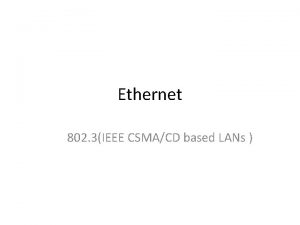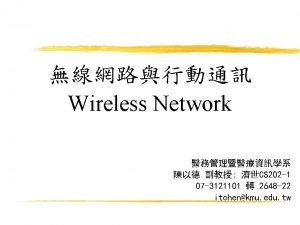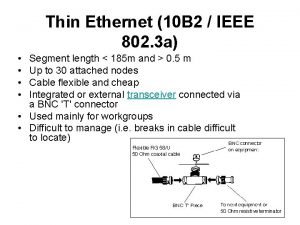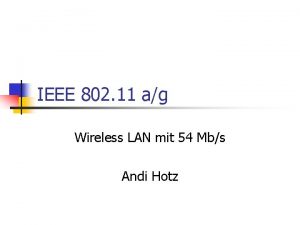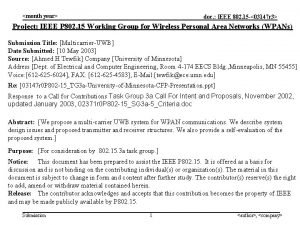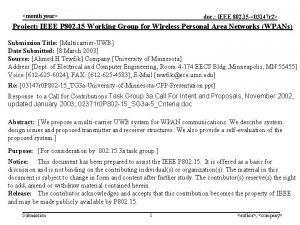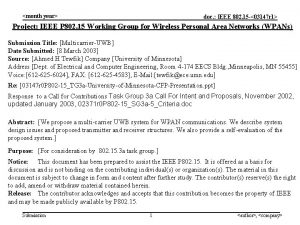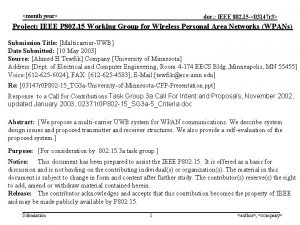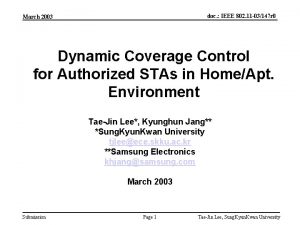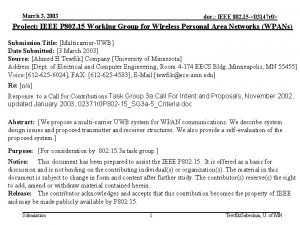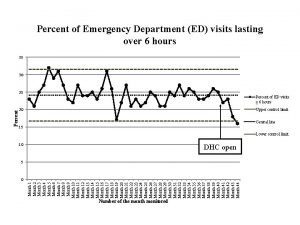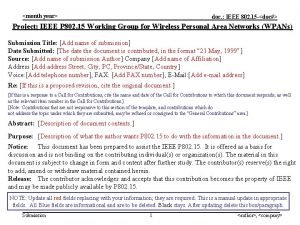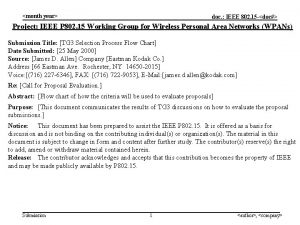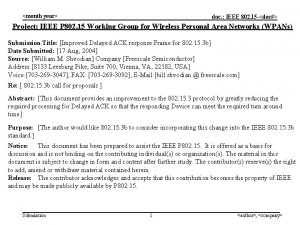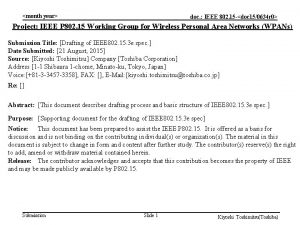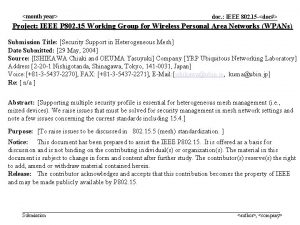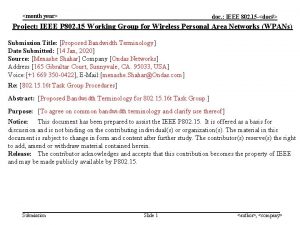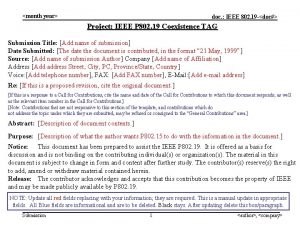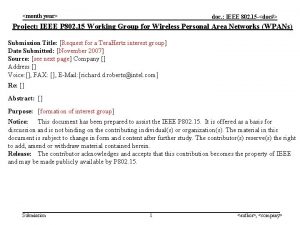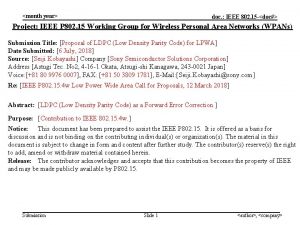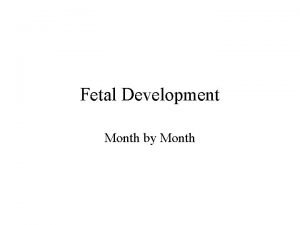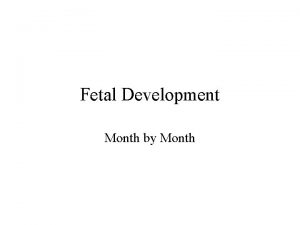month year doc IEEE 802 15 03147 r




















- Slides: 20

<month year> doc. : IEEE 802. 15 -<03147 r 4> Project: IEEE P 802. 15 Working Group for Wireless Personal Area Networks (WPANs) Submission Title: [Pulsed-UWB-OFDM] Date Submitted: [14 July 2003] Source: [Ahmed H Tewfik] Company [University of Minnesota] Address [Dept. of Electrical and Computer Engineering, Room 4 -174 EECS Bldg. , Minneapolis, MN 55455] Voice: [612 -625 -6024], FAX: [612 -625 -4583], E-Mail: [tewfik@ece. umn. edu] Re: [03147 r 0 P 802 -15_TG 3 a-University-of-Minnesota-CFP-Presentation. ppt] Response to a Call for Contributions Task Group 3 a Call For Intent and Proposals, November 2002, updated January 2003, 02371 r 0 P 802 -15_SG 3 a-5_Criteria. doc Abstract: [We propose a multi-carrier UWB system for WPAN communications. We describe system design issues and proposed transmitter and receiver structures. We also provide a self-evaluation of the proposed system. ] Purpose: [For consideration by 802. 15. 3 a task group. ] Notice: This document has been prepared to assist the IEEE P 802. 15. It is offered as a basis for discussion and is not binding on the contributing individual(s) or organization(s). The material in this document is subject to change in form and content after further study. The contributor(s) reserve(s) the right to add, amend or withdraw material contained herein. Release: The contributor acknowledges and accepts that this contribution becomes the property of IEEE and may be made publicly available by P 802. 15. Submission 1 <author>, <company>

July 14, 2003 doc. : IEEE 802. 15 -<03147 r 4> Pulsed-UWB-OFDM A. H. Tewfik and E. Saberinia B. University of Minnesota Submission 2 Tewfik/Saberinia, U. of MN

July 14, 2003 • • • doc. : IEEE 802. 15 -<03147 r 4> Overview Pulsed-UWB-OFDM Comparison with Pure-OFDM Proposed System Transmitter and Receiver Structures Coexistence and Multiple piconets Complexity and Power Consumption Conclusion Submission 3 Tewfik/Saberinia, U. of MN

July 14, 2003 doc. : IEEE 802. 15 -<03147 r 4> Basic Idea • Using OFDM modulation to simplify channel equalization, capturing channel energy and digital modem implementation • Using Pulsed-OFDM instead of normal OFDM to add the ability of getting the advantages of multi-path diversity and decreasing Complexity • Dividing the whole bandwidth to multiple subbands and hopping between these bands in order to frequency spreading and multipiconet support Submission 4 Tewfik/Saberinia, U. of MN

July 14, 2003 doc. : IEEE 802. 15 -<03147 r 4> What is Pulsed-OFDM? • A Pulsed OFDM symbol is frequency spreading of OFDM signal using a shaping pulse that is wider than the bandwidth of OFDM signal • This is equal to using a pulse with duty cycle less than 1 for sending every symbol out of OFDM modulation ( out of IFFT block) Submission 5 Tewfik/Saberinia, U. of MN

July 14, 2003 doc. : IEEE 802. 15 -<03147 r 4> Normal OFDM block in Time-Frequency • symbol rate=1/Tu f(MHz) W 31 30 • W=symbol rate 1 0 0 0 Submission 6 NTu Tewfik/Saberinia, U. of MN t

July 14, 2003 doc. : IEEE 802. 15 -<03147 r 4> Pulsed OFDM block in Time-Frequency • symbol rate=1/T • W=1/Tu=symbol rate*(T/Tu) ( frequency spreading ) f(MHz) W 0 0 Submission 31 30 1 0 31 30 1 0 31 30 1 0 1 0 Tu T=4 Tu T+Tu 7 (N-1)T+ Tu Tewfik/Saberinia, U. of MN t

July 14, 2003 doc. : IEEE 802. 15 -<03147 r 4> Multi-path diversity in Pulsed-OFDM • In Pulsed OFDM we can resolve multipath for delays: t<T-Tu • Lets Spreading gain is equal K=T/Tu be an integer • Then we can resolve K multipath (get K independent virtual channel) Submission 8 Tewfik/Saberinia, U. of MN

July 14, 2003 doc. : IEEE 802. 15 -<03147 r 4> Simulation Results • Submission Simulation For CM 4 9 Tewfik/Saberinia, U. of MN

July 14, 2003 doc. : IEEE 802. 15 -<03147 r 4> Single-Channel To Multi-Channel A pulsed-UWB-OFDM over a channel with L tap Pure-OFDM over K independent channel with L/K tap K=T/Tr Submission 10 Tewfik/Saberinia, U. of MN

July 14, 2003 doc. : IEEE 802. 15 -<03147 r 4> Single-Channel To Multi-Channel • Provides K multipath diversity • Captures all the channel energy • K=1 is pure OFDM • K=channel length is Multi-band system Submission 11 Tewfik/Saberinia, U. of MN

July 14, 2003 doc. : IEEE 802. 15 -<03147 r 4> Spectrum • Bandwidth=1. 65 GHz • Multipath resolution=0. 6 ns Submission • Bandwidth=7. 5 GHz • Multipath resolution=0. 13 ns 12 Tewfik/Saberinia, U. of MN

July 14, 2003 doc. : IEEE 802. 15 -<03147 r 4> Proposed System • • • N=32 Subcarrier C=8 Cyclic Prefix 2/3 Convolutional Channel Coding QPSK Constellation Ts=1. 8 ns Duty Cycle • • Submission K=4 for 110 Mbits/s (4 multipath diversity) K=3 for 165 Mbits/s (3 multipath diversity) K=2 for 220 Mbits/s (2 multipath diversity) K=1 for 440 Mbits/s 13 Tewfik/Saberinia, U. of MN

July 14, 2003 doc. : IEEE 802. 15 -<03147 r 4> Transmitter Input Data Convolutional Encoder Interleaver Constellation Mapping IFFT Insert Pilots Add CP & GI DAC exp(j 2 pfct) Frequency Hopping Submission 14 Tewfik/Saberinia, U. of MN

July 14, 2003 doc. : IEEE 802. 15 -<03147 r 4> Receiver cos(2 pf ct) LPF BPF VGA ADC Remove CP ADC 4 x 32 -point FFT LNA LPF VGA One Tape equalizer and combine channels sin (2 pf ct) Decoder Submission De interleaver 15 De mapping Tewfik/Saberinia, U. of MN

July 14, 2003 doc. : IEEE 802. 15 -<03147 r 4> Transmitter Complexity • 2/3 Convolution Coder • IFFT • 32 -point • QPSK only • D/A operating at 130 to 520 MHz Submission 16 Tewfik/Saberinia, U. of MN

July 14, 2003 doc. : IEEE 802. 15 -<03147 r 4> Receiver Complexity • Simple equalization and channel estimation using cyclic prefix and FFT: – 4 x 32 -Point QPSK FFT – 128 1 -tap equalizer • decoder Submission 17 Tewfik/Saberinia, U. of MN

July 14, 2003 doc. : IEEE 802. 15 -<03147 r 4> Coexistence Submission 18 Tewfik/Saberinia, U. of MN

July 14, 2003 doc. : IEEE 802. 15 -<03147 r 4> Multiple Piconets • Simultaneous operation achieved by proper selection of: – FH code – Use of pilots – Add pseudo-random codes on top of modulation – Combination Submission 19 Tewfik/Saberinia, U. of MN

July 14, 2003 doc. : IEEE 802. 15 -<03147 r 4> Conclusion • Pulsed-UWB-OFDM used OFDM modulation in order to: – Avoids Rake type receiver with reasonable size FFT-IFFT – Simple channel equalization and synchronization – Capture the channel energy • Pulsed OFDM use Pulsating normal OFDM in order to: – Frequency spreading – Providing multipath diversity – Decrease the complexity of the transceiver Submission 20 Tewfik/Saberinia, U. of MN
 Bridges from 802.x to 802.y
Bridges from 802.x to 802.y Bridges from 802.x to 802.y
Bridges from 802.x to 802.y Ieee 802
Ieee 802 Ieee 802 family
Ieee 802 family Ieee 802 3 compliance
Ieee 802 3 compliance Ieee 802
Ieee 802 Arquitetura ieee 802
Arquitetura ieee 802 Estandares 802
Estandares 802 Ieee 802 standard
Ieee 802 standard Ieee 802 bluetooth
Ieee 802 bluetooth 802 ieee
802 ieee What month is nissan
What month is nissan Sidereal vs synodic moon
Sidereal vs synodic moon Fbla study guide
Fbla study guide Favorite month of the year
Favorite month of the year Say goodbye year 6 leavers poem
Say goodbye year 6 leavers poem Ethernet 802
Ethernet 802 802 family
802 family 802-3-ethernet
802-3-ethernet Lan 701
Lan 701 Wireless lan 802
Wireless lan 802











